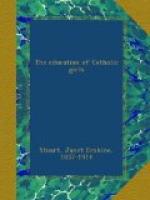There must necessarily be a principle of selection, but one of the elements to be considered in making choice ought always to be that of proportion and of fitness in adaptation to a general scheme. It was pointed out by Sir Joshua Fitch in his “Lessons on Teaching” (an old-fashioned book now, since it was published before the deluge of “Pedagogics,” but still valuable) that an ideal plan of teaching history to children might be found in the historical books of Holy Scripture, and in practice the idea is useful, suggesting that one aim should be kept in view, that at times the guiding line should contract to a mere clue of direction, and at others expand into very full and vivid narrative chiefly in biographical form. The principle may be applied in the teaching of any history that may be given to children, that is to say, in general, to Sacred history which has its own place in connexion with religious teaching, to ancient history within very small limits, to Greek and Roman history in such proportion as the years of education may allow, and to the two most prominent and most necessary for children, the history of their own country and that of modern Europe directed along the lines of the history of the Church.
There are periods and degrees of development in the minds of children to which correspond different manners of teaching and even different objects, as we make appeal to one or other of the growing faculties. The first stage is imaginative, the second calls not only upon the imagination and memory but upon the understanding, and the third, which is the beginning of a period of fruition, begins to exercise the judgment, and to give some ideas concerning principles of research and criticism.
The first is the period of romance, when by means of the best myths of many nations, from their heroic legends and later stories, the minds of children are turned to what is high and beautiful in the traditions of the past, and they learn those truths concerning human life and destiny which transcend the more limited truths of literal records of fact. In the beginning they are, to children, only stories, but we know ourselves that we can never exhaust the value of what came to us through the story of the wanderings of Ulysses, or the mysterious beauty of the Northern and Western myths, as the story of Balder or the children of Lir. The art of telling stories is beginning to be taught with wonderful power and beauty, the storyteller is turning into the pioneer of the historian, coming in advance to occupy the land, so that history may have “staked out a claim” before the examining bodies can arrive, in the dry season, to tread down the young growth.




